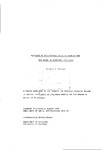PATTERNS OF OCCUPATIONAL MOBILITY AMONGST MEN AND WOMEN IN SCOTLAND: 1930-1970
| dc.contributor.author | Chapman, Anthony D. | |
| dc.contributor.other | Faculty of Arts, Humanities and Business | en_US |
| dc.date.accessioned | 2013-09-10T10:00:34Z | |
| dc.date.available | 2013-09-10T10:00:34Z | |
| dc.date.issued | 1984 | |
| dc.identifier | NOT AVAILABLE | en_US |
| dc.identifier.uri | http://hdl.handle.net/10026.1/1621 | |
| dc.description.abstract |
Researchers and writers on occupational and social mobility have attracted a good deal of criticism over the past ten years because they have not included women in their analyses. Accusations of 'intellectual' sexism have provoked different responses from researchers in this field; some have tried to remedy the empirical and theoretical deficiencies of earlier research, whilst others refute the validity of such attacks at a theoretical level. In this thesis it is argued that the exclusion of women from mobility analysis is unacceptable at a theoretical level. Those researchers who have not considered the case of women's mobility, it is argued, have done so because of methodological inconvenience. The empirical component of this thesis considers the differential patterns of occupational mobility amongst men and women in Scotland between 1930 and 1970. Drawing on data from the Scottish Mobility Study the analysis proceeds on a number of levels including discussion of national trends, variations of employment distribution and mobility in rural and urban areas, and in industrial sectors. Interpretation of these data is problematic because most analytical techniques which have been adopted by conventional mobility researchers have been devised to study only men. Consequently a strong theoretical and historical component is introduced in order to explain differential patterns of mobility. In terms of substantive findings, the thesis demonstrates that patterns of intergenerational mobility vary considerably between men and women. There appears to be a strong relationship between origin and destination for men but not for women. Also, it is demonstrated that the career patterns of men and women are quite different. Men, it appears, are much more likely to make strong career advancements whilst women's employment relationship is affected by certain contingencies. Interpretation of these findings is problematic without access to data on these contingencies. This applies not only to women, but men also. It i s argued in conclusion that it is necessary to adopt a complementary qualitative approach to assess the circumstances in which men and women as individuals and in families, pursue careers. | |
| dc.language.iso | en | en_US |
| dc.publisher | University of Plymouth | en_US |
| dc.title | PATTERNS OF OCCUPATIONAL MOBILITY AMONGST MEN AND WOMEN IN SCOTLAND: 1930-1970 | en_US |
| dc.type | Thesis | |
| plymouth.version | Full version | en_US |
| dc.identifier.doi | http://dx.doi.org/10.24382/4093 |
Files in this item
This item appears in the following Collection(s)
-
01 Research Theses Main Collection
Research Theses Main


